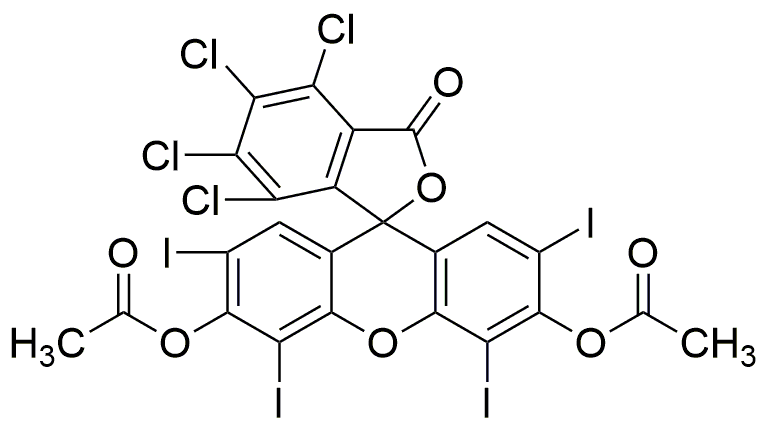Rose Bengal diacetate is widely utilized in research focused on:
- Photodynamic Therapy: This compound is effective in treating certain types of cancer by using light to activate the dye, which then produces reactive oxygen species that can kill cancer cells.
- Fluorescent Tracers: In biological research, it serves as a fluorescent marker, allowing scientists to visualize cellular processes under a microscope, enhancing the understanding of cell dynamics.
- Environmental Monitoring: It is used in assessing water quality, as it can indicate the presence of pollutants through its photochemical properties, aiding in environmental protection efforts.
- Histology and Pathology: The compound is applied in staining techniques, helping pathologists to identify and differentiate between various tissue types in diagnostic samples.
- Antimicrobial Applications: With its ability to generate reactive oxygen species, it shows promise in developing antimicrobial treatments, particularly against resistant bacterial strains.
General Information
Properties
Safety and Regulations
Applications
Rose Bengal diacetate is widely utilized in research focused on:
- Photodynamic Therapy: This compound is effective in treating certain types of cancer by using light to activate the dye, which then produces reactive oxygen species that can kill cancer cells.
- Fluorescent Tracers: In biological research, it serves as a fluorescent marker, allowing scientists to visualize cellular processes under a microscope, enhancing the understanding of cell dynamics.
- Environmental Monitoring: It is used in assessing water quality, as it can indicate the presence of pollutants through its photochemical properties, aiding in environmental protection efforts.
- Histology and Pathology: The compound is applied in staining techniques, helping pathologists to identify and differentiate between various tissue types in diagnostic samples.
- Antimicrobial Applications: With its ability to generate reactive oxygen species, it shows promise in developing antimicrobial treatments, particularly against resistant bacterial strains.
Documents
Safety Data Sheets (SDS)
The SDS provides comprehensive safety information on handling, storage, and disposal of the product.
Product Specification (PS)
The PS provides a comprehensive breakdown of the product’s properties, including chemical composition, physical state, purity, and storage requirements. It also details acceptable quality ranges and the product's intended applications.
Certificates of Analysis (COA)
Search for Certificates of Analysis (COA) by entering the products Lot Number. Lot and Batch Numbers can be found on a product’s label following the words ‘Lot’ or ‘Batch’.
*Catalog Number
*Lot Number
Certificates Of Origin (COO)
This COO confirms the country where the product was manufactured, and also details the materials and components used in it and whether it is derived from natural, synthetic, or other specific sources. This certificate may be required for customs, trade, and regulatory compliance.
*Catalog Number
*Lot Number
Safety Data Sheets (SDS)
The SDS provides comprehensive safety information on handling, storage, and disposal of the product.
DownloadProduct Specification (PS)
The PS provides a comprehensive breakdown of the product’s properties, including chemical composition, physical state, purity, and storage requirements. It also details acceptable quality ranges and the product's intended applications.
DownloadCertificates of Analysis (COA)
Search for Certificates of Analysis (COA) by entering the products Lot Number. Lot and Batch Numbers can be found on a product’s label following the words ‘Lot’ or ‘Batch’.
*Catalog Number
*Lot Number
Certificates Of Origin (COO)
This COO confirms the country where the product was manufactured, and also details the materials and components used in it and whether it is derived from natural, synthetic, or other specific sources. This certificate may be required for customs, trade, and regulatory compliance.


